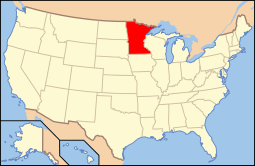Milford Mine
|
Entrance to the Milford Mine site | |
| Date | February 5, 1924 |
|---|---|
| Location | Milford Mine, Wolford Township, Minnesota |
| Casualties | |
| 41 killed | |
| 7 survivors | |
|
Milford Mine Historic District | |
  | |
| Coordinates | 46°32′5″N 93°58′15″W / 46.53472°N 93.97083°WCoordinates: 46°32′5″N 93°58′15″W / 46.53472°N 93.97083°W |
| Area | 180 acres (73 ha) |
| Built | 1912–1932 |
| Architectural style | No style listed |
| NRHP Reference # | 11000525[1] |
| Designated HD | August 10, 2011 |
The Milford Mine was an underground mine in Wolford Township, Minnesota, United States. On February 5, 1924, it was the site of the Milford Mine Disaster, the worst mining accident in Minnesota history, during which it was flooded by water from a nearby lake, killing 41 miners, while only seven men were able to climb to safety.[2] Starting in 2010 the site has been under development by Crow Wing County as Milford Mine Memorial Park. The property was listed as the Milford Mine Historic District on the National Register of Historic Places in 2011 for having state-level significance in the themes of industry and historical archaeology.[3] It was nominated for its association with a significant event in Minnesota history, and for potential archaeological resources that could illuminate mining technology, the rise and fall of iron-ore mining on the Cuyuna Range, and the daily lives of its workers.[4]
Background
First mined for manganese in 1917, the Milford Mine reached depths of 200 feet (61 m) by 1924 under its owner George H. Crosby, and 70,000 tons of ore were mined and shipped this same year. Manganese ore, an ingredient used to make steel, was shipped from the Milford site to Duluth then to steel factories in cities including Detroit and Cleveland.[2]
Disaster
The disaster occurred when a surface cave-in at the mine's easternmost end tapped into mud that was a direct connection to Foley Lake. In less than twenty minutes the mineshaft flooded to within 15 to 20 feet (4.6 to 6.1 m) of the surface. Seven men made it to ground level, while 41 were overcome by the water or trapped in mud. The last victim was recovered nine months after the disaster.[2]
15-year-old Frank Hrvatin, Jr., one of the survivors, worked alongside his father Frank Hrvatin, Sr. in the mine. On February 5, Hrvatin, Jr. was working with his senior partner Harry Hosford. When they saw the floodwater, they ran for the ladder that ascended 200 feet (61 m) to the surface. Miner Matt Kangas was ahead of them on the ladder. As the water rose and Kangas slowed because of the effort to climb such a distance, Hrvatin climbed between Kangas' legs and propelled the man up the ladder. Hosford was waist-deep in water when Hrvatin reached down and pulled Hosford out of the mine. They were the last three miners to make it out alive. Frank Hrvatin, Sr. was deeper in the mine and did not survive.[2]
Aftermath
38 of the 41 miners who drowned were married, leaving behind more than 80 children.[2]
Recovery efforts were both delicate and dangerous, as the mine was filled with mud and debris and workers worried about potential cave-ins. It took months to recover the men's bodies. The last body was removed on November 9th. The mine resumed operations soon after that.[2]
To investigate the disaster, Minnesota governor J. A. O. Preus appointed a five-man committee, which held hearings in May and June. The committee's final report said, "No blame can be attached to the mining company for this unfortunate accident. The real cause of the disaster was the fact that imminence and danger from such a rush of mud was not recognized by anyone."[2]
In 1932 with the decline of the need for steel during the Great Depression, the mine closed.[2]
See also
References
 This article incorporates text from MNopedia, which is licensed under the Creative Commons Attribution-ShareAlike 3.0 Unported License
This article incorporates text from MNopedia, which is licensed under the Creative Commons Attribution-ShareAlike 3.0 Unported License
- ↑ National Park Service (2010-07-09). "National Register Information System". National Register of Historic Places. National Park Service.
- 1 2 3 4 5 6 7 8 Fitzgerald, John (2016-03-11). "Milford Mine Disaster, 1924". MNopedia. Minnesota Historical Society. Retrieved 2016-07-17.
- ↑ "Milford Mine Historic District". Minnesota National Register Properties Database. Minnesota Historical Society. 2009. Retrieved 2015-06-19.
- ↑ Terrell, Michelle M. (2010-08-06). "National Register of Historic Places Registration Form: Milford Mine Historic District" (PDF). National Park Service. Retrieved 2012-11-24.

